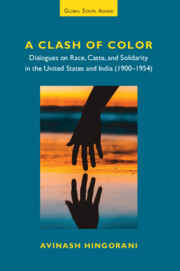 A Clash of Color
A Clash of Color Book contents
- Frontmatter
- Dedication
- Contents
- Acknowledgments
- Prologue
- Introduction
- 1 Rabindranath Tagore in America: Ideas and Impact
- 2 Lala Har Dayal, Taraknath Das, and the Ghadar Party
- 3 Lala Lajpat Rai and W. E. B. Du Bois
- 4 Lala Lajpat Rai in India
- 5 W. E. B. Du Bois and the Indian Independence Movement
- 6 W. E. B. Du Bois, Walter White, and B. R. Ambedkar’s Quest to Address Race, Caste, and Class
- Epilogue
- Bibliography
- Index
4 - Lala Lajpat Rai in India
Published online by Cambridge University Press: 28 November 2024
- Frontmatter
- Dedication
- Contents
- Acknowledgments
- Prologue
- Introduction
- 1 Rabindranath Tagore in America: Ideas and Impact
- 2 Lala Har Dayal, Taraknath Das, and the Ghadar Party
- 3 Lala Lajpat Rai and W. E. B. Du Bois
- 4 Lala Lajpat Rai in India
- 5 W. E. B. Du Bois and the Indian Independence Movement
- 6 W. E. B. Du Bois, Walter White, and B. R. Ambedkar’s Quest to Address Race, Caste, and Class
- Epilogue
- Bibliography
- Index
Summary
After Rai returned to India in December 1919, he sought to apply what he had learned in America to his own activism in India. Inspired by the Rand School of Social Science, Rai formed the Tilak School of Politics in 1921 to educate underprivileged Indians. He also started his own newspaper, The People, to circulate his ideas on caste and racial science, and his opinions on Gandhian non-violence tactics. Rai's views regarding the effectiveness of Gandhian techniques evolved throughout the 1920s. At the start of the decade, he supported Gandhi's non-violence strategy. However, Rai questioned passive resistance as a viable method for overthrowing White supremacy and the British Raj following the failure of the non-cooperation movement in 1922 and his exposure to Du Bois's articles in The Crisis describing the mass lynchings of Black Americans in the 1921 Tulsa race massacre. Rai came to see violent encounters as an inevitability during social clashes predicated upon race and class. Sadly, this violence came to claim Rai's life. On October 30, 1928, Rai himself led a protest against the British to challenge their lack of inclusion of Indians on the Indian Statutory Commission, which was a group of seven White British members of parliament chosen by the British government to study constitutional reform in India. During the protest, British police superintendent James A. Scott ordered the police to attack the protesters and Scott personally assaulted Rai. Rai died a month later, never recovering from the injuries inflicted upon him.
Up until his death, Rai's outlook continued to evolve. Alongside his thoughts on violent protest, his perception of caste changed throughout the 1920s. While Rai saw India's caste problem as a secondary issue early in the decade, by the tail end of his life, Rai had brought the matter to the forefront of the Indian independence movement. He actively sought the abolition of caste discrimination and sub-castes even to the point that he considered postponing Swaraj to solve the issue of caste. This showed that Rai actively sought caste reform and advocated for the abolition of sub-castes. In the many articles that Rai wrote in The People, he condemned caste discrimination explicitly and stressed that India could never achieve unity and become a functional democracy so long as caste discrimination remained.
- Type
- Chapter
- Information
- A Clash of ColorDialogues on Race, Caste, and Solidarity in the United States and India (1900–1954), pp. 76 - 103Publisher: Cambridge University PressPrint publication year: 2025
